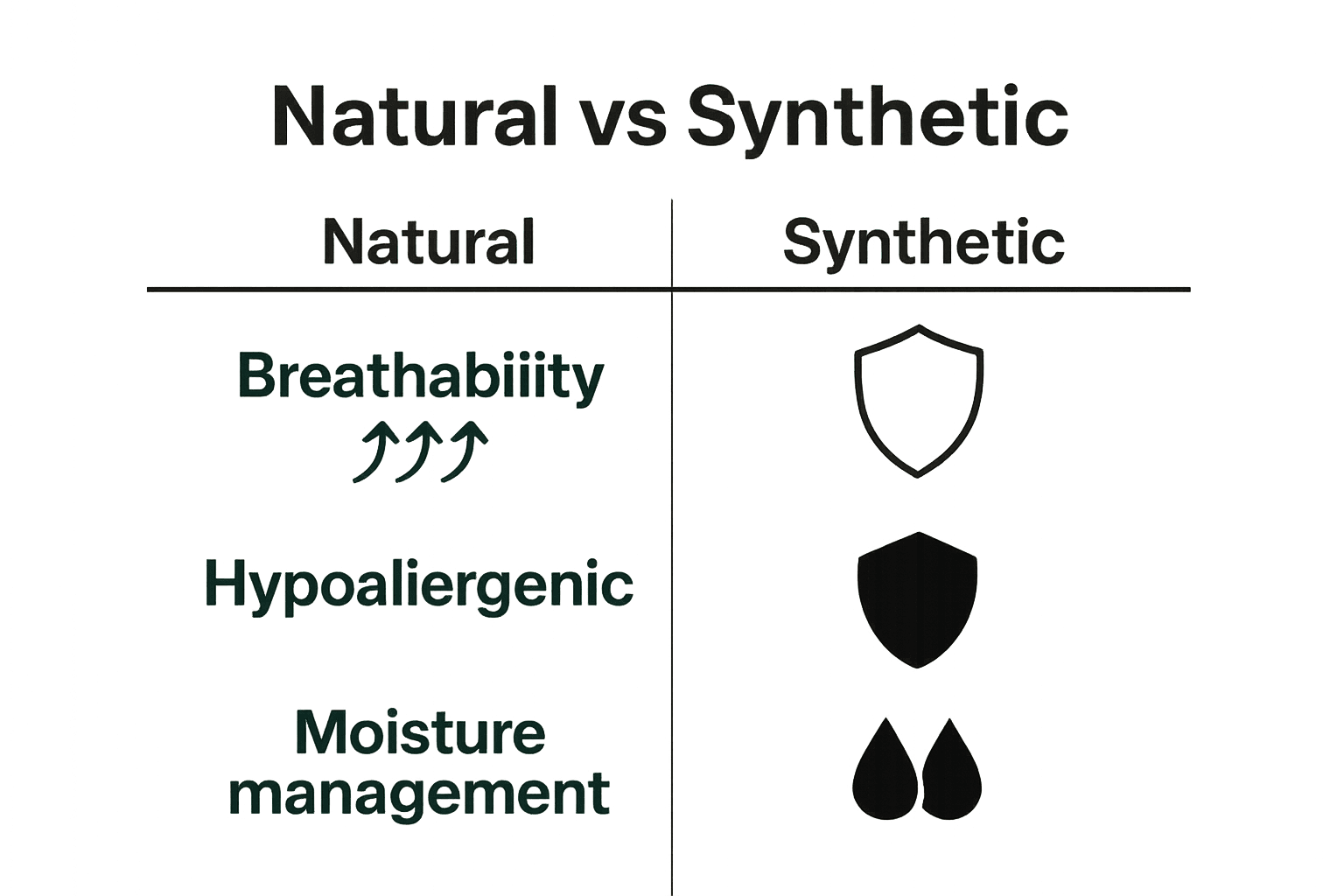
Best Fabrics for Sensitive Skin: Complete Guide
Share
Did you know that over 50 percent of people with sensitive skin report flare-ups after wearing certain fabrics? The wrong clothing can leave your skin red, itchy, or uncomfortable day after day. Finding the right fabric can help calm these reactions and make a real difference in daily comfort. This guide uncovers the best and worst materials for delicate skin, plus what makes a textile truly gentle.
Key Takeaways
| Point | Details |
|---|---|
| Natural Fabrics Are Best for Sensitive Skin | Fabrics like organic cotton, bamboo, and Tencel provide breathability, softness, and hypoallergenic properties, making them ideal for those with sensitivities. |
| Avoid Synthetic Materials | Synthetic fabrics may trap heat and moisture and often contain chemical treatments that can irritate sensitive skin. |
| Look for Hypoallergenic Labels | When purchasing textiles, seek out items with hypoallergenic certifications to minimize the risk of allergic reactions. |
| Be Aware of Potential Irritants | Even natural fabrics can contain hidden irritants; therefore, individuals should stay vigilant for any signs of irritation from additives or processing chemicals. |
Table of Contents
- Defining Fabrics Suitable For Sensitive Skin
- Common Fabric Types And Their Benefits
- Key Characteristics For Skin Comfort
- Potential Irritants And Common Reactions
- Comparing Natural And Synthetic Alternatives
Defining Fabrics Suitable for Sensitive Skin
When it comes to sensitive skin, not all fabrics are created equal. Some materials can trigger irritation, inflammation, and discomfort faster than you might imagine. According to research from Heavenly Health, natural fabrics like cotton, linen, and bamboo stand out as superior choices for individuals with skin sensitivities.
What makes these natural fabrics so special? They offer several key advantages for sensitive skin:
- Breathability: Allows air circulation, reducing heat and moisture buildup
- Softness: Minimizes friction and potential skin irritation
- Hypoallergenic properties: Less likely to trigger allergic reactions
Synthetic fabrics, by contrast, often present challenges for sensitive skin. They tend to trap sweat, retain heat, and may contain chemical treatments that provoke skin reactions. As the research indicates, organic certified textiles can help avoid harsh substances that might trigger irritation.
Hypoallergenic materials represent another critical category for sensitive skin. According to Wikipedia, these textiles are specifically engineered and tested to reduce the likelihood of provoking allergic responses. When shopping for clothing or bedding, looking for hypoallergenic certifications can provide an additional layer of protection for those with delicate skin conditions.
Common Fabric Types and Their Benefits
Sensitive skin demands thoughtful fabric selection. According to research from Public Myth, several natural fabrics stand out as exceptional choices for individuals experiencing skin sensitivities. Each fabric offers unique properties that can help soothe and protect delicate skin.
Here’s a comparison of popular fabrics for sensitive skin:
| Fabric Type | Key Benefits | Potential Drawbacks |
|---|---|---|
| Organic Cotton | Soft Breathable Hypoallergenic |
May shrink Wrinkle-prone |
| Tencel Lyocell | Silky feel Moisture-wicking |
Costlier than cotton |
| Bamboo | Antimicrobial Temperature control |
Chemical processing varies |
| Merino Wool | Moisture management Odor-resistant |
Not vegan Special care |
Organic Cotton: The Gentle Favorite
Organic cotton emerges as a top performer for sensitive skin. Its characteristics include:
- Soft and breathable texture
- Hypoallergenic properties
- Minimal chemical processing
- Reduced risk of skin irritation
Tencel Lyocell: The Advanced Comfort Fabric
Tencel, also known as lyocell, represents a modern textile breakthrough. Teen Vogue highlights its remarkable qualities:
- Silky smooth feel
- Superior moisture-wicking capabilities
- Reduces friction against skin
- Helps prevent potential breakouts
Bamboo: Nature’s Antimicrobial Solution
Bamboo fabric offers another excellent option for those with sensitive skin. Its natural properties include:
- Exceptional breathability
- Antimicrobial characteristics
- Excellent temperature regulation
- Soft, gentle fiber structure
Merino Wool: The Temperature Regulator
Often overlooked, merino wool provides surprising benefits for sensitive skin:
- Excellent moisture management
- Natural temperature regulation
- Odor-resistant properties
- Soft, non-irritating fiber composition
By understanding these fabric types, you can make informed choices that prioritize skin health and comfort.
 Explore our guide on stylish compression stockings to see how these fabric principles apply to therapeutic garments.
Explore our guide on stylish compression stockings to see how these fabric principles apply to therapeutic garments.
Key Characteristics for Skin Comfort
Understanding the science behind fabric comfort is crucial for individuals with sensitive skin. According to the Times of India, natural plant-based fabrics play a transformative role in maintaining skin health by providing critical protective characteristics.
Breathability: The Foundation of Skin Comfort
Breathability emerges as the primary characteristic for skin-friendly textiles. Natural fabrics offer remarkable advantages:
- Lightweight construction
- Enhanced airflow
- Temperature regulation
- Reduced sweat accumulation
Moisture Management: Critical for Skin Health
According to Wikipedia, moisture-wicking represents a sophisticated fabric property that directly impacts skin comfort. This mechanism involves:
- Transferring moisture away from skin
- Utilizing capillary action
- Enabling rapid drying
- Preventing prolonged skin dampness
Additional Protective Characteristics
Beyond breathability and moisture management, ideal fabrics for sensitive skin should also offer:
- Minimal friction against skin
- Hypoallergenic properties
- Smooth, soft texture
- Reduced potential for irritation
Learn how to avoid skin irritation with our compression stocking guide and discover additional strategies for maintaining skin comfort and protection.
Potential Irritants and Common Reactions
Textile sensitivity is a complex issue that extends far beyond simple fabric selection. According to research from The Guardian, not all natural materials are inherently safe—even seemingly gentle ingredients can trigger unexpected skin reactions.
Chemical Processing and Synthetic Fabric Risks
Synthetic fabrics present unique challenges for sensitive skin. As noted by Denisa Rensen, these materials may contain chemical residues that can provoke significant skin responses:
- Formaldehyde resins
- Processing chemical remnants
- Potential triggers for textile dermatitis
- Higher likelihood of causing inflammation
Common Skin Reaction Indicators
Individuals with sensitive skin should watch for these warning signs of fabric-related irritation:
- Persistent redness
- Itching or burning sensations
- Localized rashes
- Unexpected skin bumps
- Increased sensitivity in contact areas
Unexpected Irritant Sources
Surprisingly, even natural additives can cause adverse reactions. Some potential hidden irritants include:
- Essential oils
- Lanolin
- Natural plant extracts
- Unexpected botanical compounds
Learn strategies for managing skin sensitivity with our compression stocking guide and discover proactive approaches to minimizing potential fabric-related skin challenges.
Comparing Natural and Synthetic Alternatives
The fabric selection battlefield between natural and synthetic materials is complex, with each category offering unique advantages and drawbacks. According to research from Spring to Life, understanding these differences is crucial for individuals with sensitive skin.
Natural Fiber Advantages
Natural fibers like cotton, linen, and wool demonstrate remarkable properties for skin health:
- Breathability: Allows optimal air circulation
- Moisture-wicking: Rapidly transfers perspiration
- Hypoallergenic: Reduces potential allergic reactions
- Biodegradable: Environmentally friendly option
Synthetic Fabric Considerations
While synthetic materials offer durability, they present potential challenges:
- Higher likelihood of trapping heat
- Potential chemical residue retention
- Less natural moisture management
- Extended product lifespan
Comprehensive Fabric Performance
According to Fashionide, natural fabrics significantly reduce allergen exposure through:

- Fewer airborne particle interactions
- Minimal chemical processing
- Superior breathability
- Enhanced moisture control
Explore our compression stocking guide for detailed fabric performance insights and discover which materials work best for your specific needs.
Discover Compression Stockings Designed for Sensitive Skin
If you find ordinary fabrics unbearable and worry about skin irritation or allergic reactions, you know how crucial the right material is for comfort and daily well-being. This guide explained the importance of breathability, hypoallergenic textiles, and gentle moisture management for protecting sensitive skin, especially when you need compression wear for conditions like varicose veins, lymphedema, or diabetes.
At Fit Stockings, we offer a curated range of medically approved compression stockings crafted with high-quality, skin-friendly fabrics. Explore our UltraSheer collection for soft, breathable options or browse trusted Jobst stockings known for gentle support without sacrificing skin health. Shop directly at Fit Stockings to find the perfect fit with free shipping and helpful sizing guidance. Experience relief and confidence—choose the best fabrics for your sensitive skin needs today.
Frequently Asked Questions
What fabrics are best for sensitive skin?
Natural fabrics like organic cotton, bamboo, and Tencel lyocell are ideal for sensitive skin due to their breathability, softness, and hypoallergenic properties.
How can I tell if a fabric is hypoallergenic?
Look for certifications specifically mentioning hypoallergenic properties in the product description. Fabrics that have undergone minimal chemical processing are also more likely to be hypoallergenic.
What are the disadvantages of synthetic fabrics for sensitive skin?
Synthetic fabrics may trap heat and moisture, retain harmful chemical residues, and are generally less breathable, which can lead to skin irritation for those with sensitivities.
How does breathability affect sensitive skin?
Breathability in fabrics allows for better air circulation, reducing heat and moisture buildup on the skin, which minimizes the risk of irritation and discomfort.
Recommended
- How to Avoid Blisters Naturally with Compression Stockings – Fit Stockings
- Washing Compression Stockings: Best Practices for 2025 – Fit Stockings
- How to Wash Compression Stockings: Easy Care Tips – Fit Stockings
- 7 Essential Compression Stocking Care Tips – Fit Stockings
- How to Understand Skin Sensitivity and Choose Products Wisely

